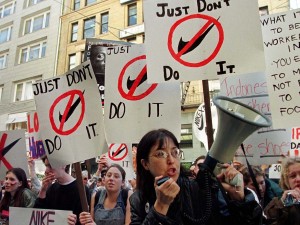
http://static2.businessinsider.com/image/518bb0b4ecad04f65d00001a/how-nike-solved-its-sweatshop-problem.jpg
“SLAVERY… if the shoe fits”, “Just DON’T Do It!”, and “BOYCOTT Nike” are just a few of the catchphrases activists have coined while boycotting the well known brand. For 20+ years anti-sweatshop activists have been shaming the retailer for their use of sweatshops- particularly usage of child labour and terrible working conditions. This unethical decision was used to maximize profits, but the outcome was not what they hoped.
In the early 1990’s reports spread on the low wages and poor conditions in the company’s factories. Immediate unrest broke out in the public. The boycotting “badly tarnished the company’s image and hurt sales” (Nisen). The very public boycott of the company forced change on the brand. They were in jeopardy of losing profit, loyal customers and their brand image. This pushed the company to reform. Nike had to use social responsibility and act in more ethical ways. Nike began putting ethics over profit and saw a large turnaround. The minimum age of workers was raised, monitoring efforts were increased, and factory sanitation improved. Because the customers were very important stakeholders to the company, Nike knew they had to make changes.
The changes may have been in the company’s own best interest, but the company was able to exhibit social responsibility. Once the changes were made, the company’s image began to improve- demonstrating that social responsibility and ethics create a successful company.
Works Cited:
Friedman, Milton. “The Social Responsibility of Business is to Increase Its Profits.” Corporate Ethics and Corporate Governance. By Walther Ch. Zimmerli, Klaus Richter, and Markus Holzinger. Berlin/Heidelberg: Springer, 2007. 177. Site.ebrary.com: The University of British Columbia Library. Web. 9 Sep. 2014.
Nisen, Max. “How Nike Solved Its Sweatshop Problem.” Business Insider. Business Insider, Inc, 09 May 2013. Web. 09 Sept. 2014.
“How Activism Forced Nike to Change Its Ethical Game.” Theguardian.com. Guardian News and Media, 06 July 2012. Web. 9 Sept. 2014.
Reporter, Daily Mail. “Nike Workers ‘kicked, Slapped and Verbally Abused’ at Factories Making Converse.” Mail Online. Associated Newspapers, n.d. Web. 09 Sept. 2014.